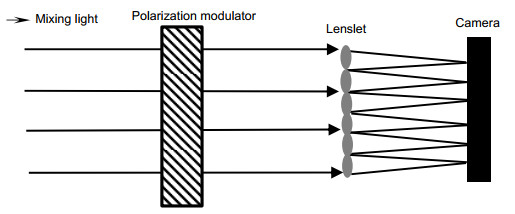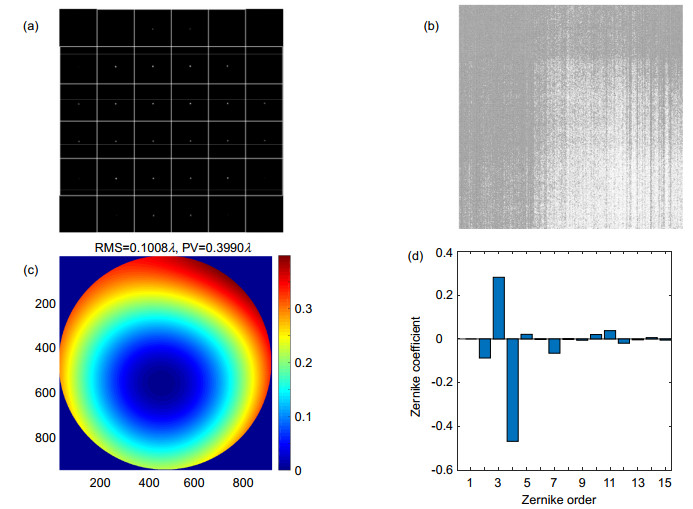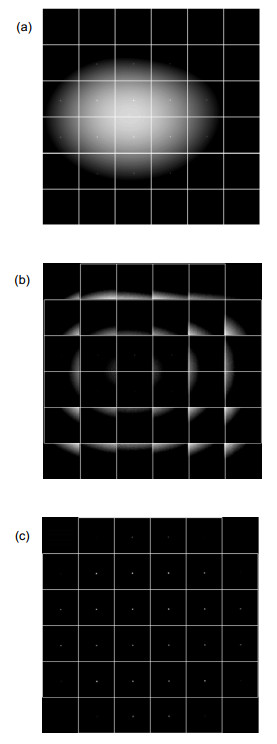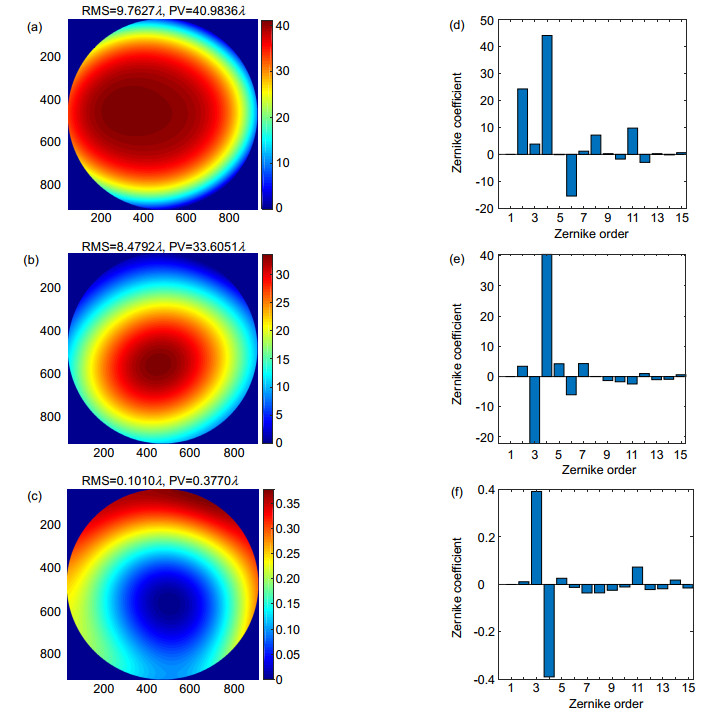-
摘要
针对白天强背景条件下自适应光学系统哈特曼传感器信背比低、波前探测精度不高等问题,利用人造目标与强背景偏振特性差异,提出基于偏振调制的哈特曼波前探测方法,将传统的哈特曼波前探测从强度维度转换到偏振维度,有效提升信背比和波前探测精度。阐述了偏振哈特曼波前探测基本方法和原理,并通过数值模拟仿真验证了方法的正确性和准确性。研究结果表明:偏振哈特曼探测技术能够有效提升强背景条件下信背比和波前探测精度,显著增强自适应光学系统在强背景条件下的工作能力。

Abstract
Aiming at the problems of low signal-to-background ratio and low wavefront detection accuracy of the adaptive optical system Hartmann sensor under strong background conditions during the day, based on the difference in polarization characteristics between man-made targets and strong backgrounds, a polarized Hartmann wavefront detection technology is proposed. The traditional Hartmann wavefront detection is converted from the intensity dimension to the polarization dimension, thereby effectively improving the signal-to-background ratio and wavefront detection accuracy. The basic methods and principles of polarized Hartmann wavefront detection are described, and the correctness and accuracy of the method are verified through numerical simulations and experiments. Theoretical and numerical simulation results show that the polarized Hartmann wavefront detection technology can effectively improve the signal-to-background ratio and wavefront detection accuracy under strong background conditions, and significantly enhance the ability of the adaptive optical system to work under strong background conditions.
-
Key words:
- adaptive optics /
- strong background /
- polarized Hartmann sensor /
- polarization modulation
-
Overview

Overview: After more than 40 years of continuous development, adaptive optics has gradually matured in theoretical exploration and engineering applications, and has been widely used in various fields. The Hartmann wavefront sensor is an important part of the adaptive optics system and is currently the most widely used wavefront detector in the adaptive optics system. When the Hartmann wavefront sensor performs wavefront detection in strong background occasions like daytime, the interference of the strong background will increase the centroid calculation error in the wavefront calculation and significantly reduce the wavefront detection accuracy, which severely limits working hours of the adaptive optics system.
Aiming at the application scenario of a large back-to-signal ratio, a new polarized Hartmann wavefront detection technology is proposed. The polarized Hartmann wavefront detector adds a polarization modulator in front of the microlens array to obtain intensity detection images under different polarization modulation states. The polarized difference principle is used to convert the directly detected intensity signal into a polarization signal, and finally, the Hartmann wavefront detection result is transformed from the intensity dimension to the polarization dimension by using the difference between the polarization characteristics of the detection target and the background light. This article describes the basic methods and principles of polarized Hartmann wavefront detection technology, and then conducts numerical simulations for linear polarization signal wavefront detection in natural light scenes, which are as follows. First, the wavefront restoration results before and after adding the strong background are compared to clarify the influence of the strong background on the Hartmann wavefront restoration results. Then, the strong background processing and wavefront restoration calculation under different back signal ratios are launched. Finally, the removal effect of the strong background and the wavefront restoration error of the subtracted global threshold method, subtracted local adaptive threshold method, and polarization difference method is compared.
Theoretical and simulation results show that the polarized Hartmann wavefront detection technology has a good removal effect on strong background, and has high wavefront restoration accuracy. This improves the signal-to-background ratio of Hartmann wavefront detection to a certain extent, and improves the accuracy of wavefront detection under strong background conditions. Therefore, the polarization Hartmann wavefront detection technology has high feasibility for wavefront detection in strong background scenes, and has a great effect on the application expansion of adaptive optics in daytime scenes.
-

-
-
参考文献
[1] Jiang W H, Li M Q, Tang G M, et al. Adaptive optical image compensation experiments on stellar objects[J]. Opt Eng, 1995, 34(1): 15-20. doi: 10.1117/12.184078
[2] Zhang R J, Li H G. Hartmann-Shack wavefront sensing and wavefront control algorithm[J]. Proc SPIE, 1990, 1271: 82-93. doi: 10.1117/12.20396
[3] 姜文汉, 鲜浩, 杨泽平, 等. 哈特曼波前传感器的应用[J]. 量子电子学报, 1995, 15(2): 228-235. https://www.cnki.com.cn/Article/CJFDTOTAL-LDXU199802014.htm
Jiang W H, Xian H, Yang Z P, et al. Applications of Shack-Hartmann wavefront sensor[J]. J Quantum Electron, 1995, 15(2): 228-235. https://www.cnki.com.cn/Article/CJFDTOTAL-LDXU199802014.htm
[4] Li H G, Jiang W H. Application of H-S wavefront sensor for quality diagnosis of optical system and light beam[C]//ICO-16 Satellite Conference on Active and Adaptive Optics, 1993: 369-376.
[5] 陈浩, 魏凌, 李恩德, 等. 基于B样条函数的快速波前复原[J]. 光电工程, 2021, 48(2): 60-69. doi: 10.12086/oee.2021.200160
Chen H, Wei L, Li E D, et al. A B-spline based fast wavefront reconstruction algorithm[J]. Opto-Electron Eng, 2021, 48(2): 60-69. doi: 10.12086/oee.2021.200160
[6] Li C H, Xian H, Rao C H, et al. Field-of-view shifted Shack-Hartmann wavefront sensor for daytime adaptive optics system[J]. Opt Lett, 2006, 31(19): 2821-2823. doi: 10.1364/OL.31.002821
[7] 姜文汉, 鲜浩, 沈锋. 夏克-哈特曼波前传感器的探测误差[J]. 量子电子学报, 1998, 15(2): 218-227. https://www.cnki.com.cn/Article/CJFDTOTAL-LDXU199802013.htm
Jiang W H, Xian H, Shen F. Detection error of Shack-Hartmann wavefront sensor[J]. J Quantum Electron, 1998, 15(2): 218-227. https://www.cnki.com.cn/Article/CJFDTOTAL-LDXU199802013.htm
[8] Beckers J M, Cacciani A. Using laser beacons for daytime adaptive optics[J]. Experimental Astronomy, 2001, 11(2): 133-143. doi: 10.1023/A:1011140920850
[9] Gonglewski J D, Highland R G, Dayton D C, et al. ADONIS: Daylight imaging through atmospheric turbulence[J]. Proc SPIE, 1996, 2827: 152-161. doi: 10.1117/12.255078
[10] 徐维安. 光谱滤波装置在白天测星中的应用[J]. 光学精密工程, 1996, 4(4): 84-88. doi: 10.3321/j.issn:1004-924X.1996.04.016
Xu W A. Application of spectral filter device in measuring stellar daytime[J]. Opt Precis Eng, 1996, 4(4): 84-88. doi: 10.3321/j.issn:1004-924X.1996.04.016
[11] 李旭旭, 李新阳, 王彩霞. 哈特曼传感器子孔径光斑的局部自适应阈值分割方法[J]. 光电工程, 2018, 45(10): 170699. doi: 10.12086/oee.2018.170699
Li X X, Li X Y, Wang C X. Local adaptive threshold segmentation method for subaperture spot of Shack-Hartmann sensor[J]. Opto-Electron Eng, 2018, 45(10): 170699. doi: 10.12086/oee.2018.170699
[12] 张锐进, 鲜浩, 饶长辉, 等. 偏振滤波白天抑制天光背景作用分析[J]. 光学学报, 2012, 32(5): 0501003. doi: 10.3788/AOS201232.0501003
Zhang R J, Xian H, Rao C H, et al. study on effect of polarization filter for suppressing sky background light in daytime[J]. Acta Opt Sin, 2012, 32(5): 0501003. doi: 10.3788/AOS201232.0501003
[13] 范真涛, 汤媛媛, 魏凯, 等. 光谱椭偏系统光源和光谱仪偏振相关系数测量[J]. 光电工程, 2019, 46(12): 180507. doi: 10.12086/oee.2019.180507
Fan Z T, Tang Y Y, Wei K, et al. Measurement of polarization correlation coefficients of light source and spectrometer in spectroscopic ellipsometry[J]. Opto-Electron Eng, 2019, 46(12): 180507. doi: 10.12086/oee.2019.180507
-
访问统计


 E-mail Alert
E-mail Alert RSS
RSS
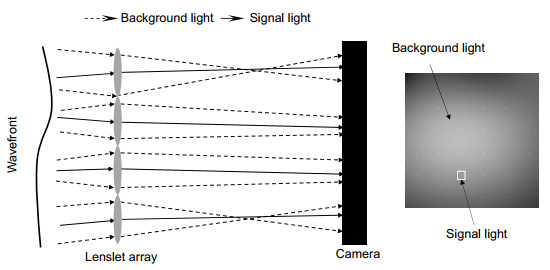
 下载:
下载:

